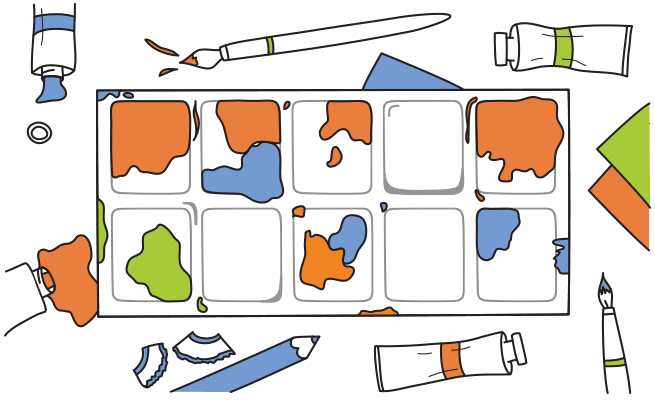
Getting your colours right will make your videos instantly more watchable. But the vast choice of colours available can make putting a colour scheme together pretty daunting. Follow these simple colour rules to make intriguing and attractive scribes.
This is the second article in a series that teaches you how to make powerful and unforgettable scribe videos. See the end of the post for more.
Limit your colour palette
First of all, restrict the number of colours you use. Too many colours can give too much contrast and the effect can be garish and unappealing. Often scribers feel like they need to use lots of colours to grab the viewer's attention, but it's even easier to emphasise elements with a limited number of colours.
Try to stick to one main colour – this will be used the most in your image or scribe. Other colours can be used but should be used in smaller amounts so as to support the main colour. Having one main colour in a scribe will give it a strong and distinctive style. It will also strengthen the sense of continuity between the different scenes.
Accent colours are those that are used more sparingly, giving a subtle emphasis to elements. The viewer will likely to be drawn to these bits of colour as they are less common throughout the whole scribe – so think carefully about which bits you want to draw attention to.
Think of colours in context

Colours give different feelings and messages depending on what other colours they are used with. The context of a colour can be used really effectively to communicate messages and ideas in your scribe.
Above shows the same red colour being used with four very different colours. Each one conveys very different emotions and feelings. For example, the black with the red gives a much stronger, darker feeling than the happier, lighter effect we get from the pink and red.
5 schemes for colour harmony
Do you remember the colour wheel from art classes in school? Here it is again, along with all the patterns you need to know to create great colour palettes.
1. Complementary colours

This is the most basic one. For complementary colours you simply use colours that are opposite to each other on the colour wheel. The principle is pretty straight forward, but you can experiment with different shades and tints to get what you are looking for.
This scheme is often used for drawing attention to something as it produces a strong visual contrast. It works best when you juxtapose a warm colour with a cool colour, e.g. red-orange versus green-blue.
Make sure you use one colour as the dominant one and the complementary colour for the accents. Don't worry if you don't get it right straight away– it can be hard to balance complementary colours well as they are so different.
2. Analogous colours

Analogous colours are those that are next to each other in the colour wheel. There is normally one dominant colour within this set, and it's good to choose colours either side of this one to make up your palette.
It is very easy to create a good palette with this system but you can sometimes lack contrast, making it harder to grab attention compared to using the complementary colours. You should stay away from using warm and cool colours together with analogous colour schemes.
3. Monochromatic colours

Monochromatic means one colour. A monochromatic scheme is simply one that uses variations in shade or tint of the same hue (or colour). This scheme is elegant and very easy on the eyes because there are no strong contrasts.
It works well when used to create an overall mood for your scribe but again, it can be a struggle to highlight different areas. Sometimes you'll see a single colour being combined with neutral colours like white, black or grey for a very classy, clean style.
4. Split-complementary colours

These final categories produce some of the more advanced colour palettes. For an effect like the example above, choose one colour and combine with two others equally spaced from its complement (the original).
Split-complementary gives a good balance between the contrast of complementary colours and the soothing appeal of analogous or monochromatic colours. Using one main warm colour as the accent colour and a range of cooler colours generates the most attractive outcomes.
5. Triad colours

Try making a triangle on the colour wheel, so that the three colours are equally spaced out. It won't be as striking as using complementary colours but will give a strong contrast whilst still retaining an appealing balance of colour. Again, it's wise to make one of these colours the main colour you use.
Useful colour tools
Adobe Kuler is a handy tool for testing out different colour schemes. You can also save your picks and come back to them later.
Colour Scheme Designer gives you the option to see an example of your colour scheme in action.
COLOURlovers is a global community where people create and share palettes and patterns, and talk about the latest colour trends.
Hailpixel is a delight to use – mouse around the screen to change the spectrum and click when you find something that you like.
More expert advice from the Better Scribes series:
- How to give your scribe a heart
- Captivate your audience with these pro colour tips
- How to record a professional sounding voiceover
- The layout lowdown from a design expert
- Why forgetting fonts is a big mistake
- 4 Easy ways to find original images for VideoScribe
- Are you guilty of these amateur timing mistakes?
- The secrets to ridiculously persuasive scribing
- How to hit the right note with scribe music
- 7 Clever tricks seasoned scribers swear by
Please share the Better Scribes articles with others who will find them useful.


.png)



![How to create animation magic [3-part guide to video success]](https://blog.videoscribe.co/hubfs/How%20to%20create%20animation%20magic%20guide%20VideoScribe.png)





COMMENTS